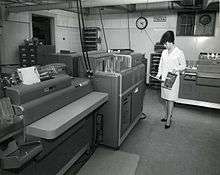Think (IBM)
 |
|
| Problems playing this file? See media help. | |



"THINK" is a slogan first used by Thomas J. Watson in December, 1911, while managing the sales and advertising departments at the National Cash Register Company.[1] At an uninspiring sales meeting Watson interrupted, saying The trouble with every one of us is that we don't think enough. We don't get paid for working with our feet — we get paid for working with our heads. Watson then wrote THINK on the easel.[2]
Asked later what he meant by the slogan, Watson replied, "By THINK I mean take everything into consideration. I refuse to make the sign more specific. If a man just sees THINK, he'll find out what I mean. We're not interested in a logic course."[3]
In 1914, Watson brought the slogan with him to the Computing-Tabulating-Recording Company (CTR) and its subsidiaries, all of which later became IBM.[4][5][6][7] International Time Recording, one of the companies consolidated to form CTR, published a magazine, Time, for employees and customers that, in 1935, IBM would rename THINK.[8][9] IBM continues to use the slogan.[10] THINK is also an IBM trademark; IBM named its laptop computers ThinkPads and named a line of business-oriented desktop computers ThinkCentre.
The Apple slogan, "Think Different" has been widely taken as a response to IBM's THINK.[11][12][13]
"THINK" entered the popular culture, often in a humorous context.[14] For early examples, see Corey Ford's Guide to Thimking.[15] Mad magazine also used a "THINK" parody motto [16] along with using the word directly on the cover of the last Mad comic book issue #23 from May 1955.[17]
References
- ↑ Random House Webster's College Dictionary. Random House. 1999. p. 1237.slogan: a distinctive phrase or motto identified with a particular party, product, etc.
- ↑ Belden, Thomas; Belden, Marva (1962). The Lengthening Shadow: The Life of Thomas J. Watson. Little, Brown and Company. pp. 157–8.
- ↑ Belden (1962) p.158
- ↑ IBM Archives: THINK Sign
- ↑ Maney, Kevin (2003). The Maverick and His Machine: Thomas Watson, Sr., and the Making of IBM. Wiley. ISBN 0-471-41463-8.
- ↑ Tedlow, Richard S. (2003). The Watson Dynasty. Harper Business. ISBN 0-06-001405-9.
- ↑ Engelbourg, Saul (1954). International Business Machines: A Business History (Ph.D.). Columbia University. pp. 103–105. Reprinted by Arno Press, 1976, from the best available copy. Some text is illegible.
- ↑ Aswad, Ed; Meredith, Suzanne M. (2005). IBM in Endicott. Arcadia. p. 18.
- ↑ Cousins, Robert (ed) (1957). The Will to THINK: A Treasury of Ideas and Ideals from the Pages of THINK. Farrar, Straus and Cudahy. The books introduction, The Thinking Man, was written by Thomas J. Watson.
- ↑ Think Exhibit
- ↑ Clifton, Rita; Ahmad, Sameena (2009). Brands and Branding. The Economist. Bloomberg Press. p. 116. ISBN 978-1576601471.
- ↑ Altstiel, Tom; Grow, Jean (2005). Advertising Strategy: Creative Tactics from the Outside/In. Sage Publications, Inc. p. 24. ISBN 978-1412917964.
- ↑ Sull, Donald Norman (2003). Revival of the Fittest: Why Good Companies Go Bad and How Great Managers Remake Them. Harvard Business Review Press. p. 66. ISBN 978-1578519934.
- ↑ Maney, Kevin (2003). The Maverick and His Machine. Wiley. p. 437.
- ↑ Ford, Corey (1961). Guide to Thimking. Doubleday.
- ↑ Mad magazine THIMK
- ↑ Mad comic #23, May 1955
External links
| Wikimedia Commons has media related to Think signs. |